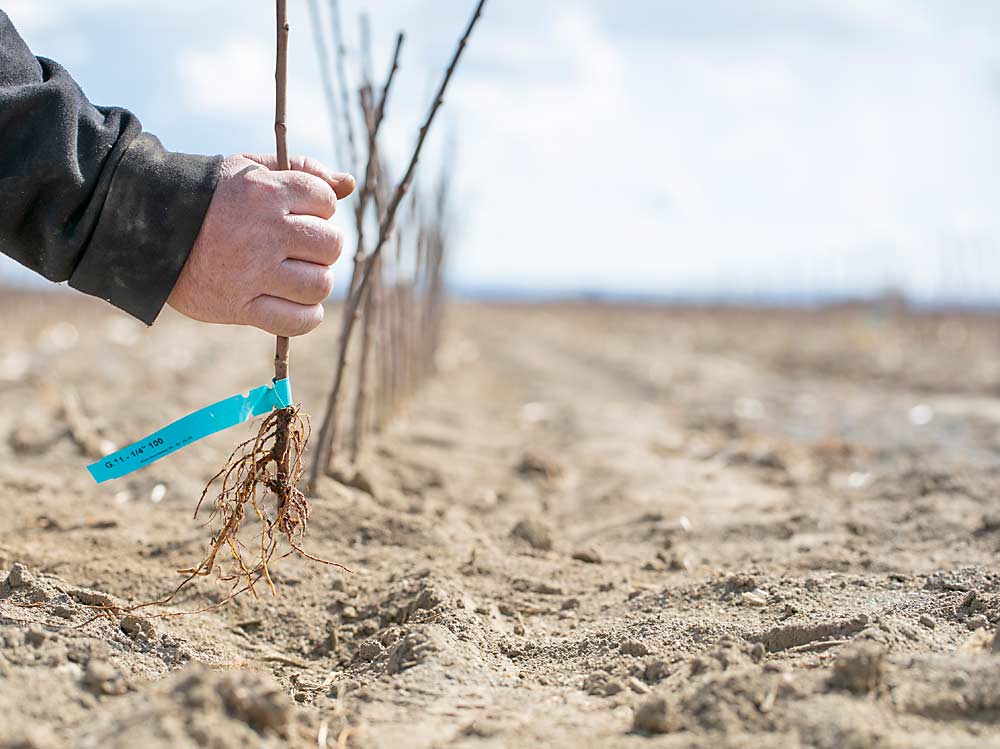
Don’t forget about the tried and true when it comes to picking rootstocks.
The battle-tested Geneva 11 has been around the block and still checks most of the boxes for growers’ desired characteristics. Even new data seems to back it up.
That’s the message from a couple of Northwest stool bed nurseries in the current era of trying to match scion, growing conditions and soil to a bevy of designer rootstock offerings sometimes in short supply.
“It just seems to be an overall, well-rounded universal rootstock,” said Jim Adams, co-owner of Willow Drive Nursery in Ephrata, Washington. Willow Drive is one of the world’s largest producers of G.11.
Released in the late 1990s by Cornell University, Geneva 11 has grown into one of the stars of a breeding program now run as a partnership between the university and the U.S. Department of Agriculture in Geneva, New York. It has become one of the industry’s workhorses, often replacing Malling 9, Budagovsky 9 and other traditional rootstocks.
“He does have a point,” said Gennaro Fazio, a USDA Agricultural Research Service breeder and geneticist. “G.11 is the new M.9.”
No rootstock is perfect, said Terence Robinson of Cornell University, who leads trials on the Geneva releases, but G.11 has many desired rootstock traits.
It is resistant to fire blight, moderately tolerant to replant disease, moderately more cold-tolerant than M.9 and less susceptible to bitter pit than Geneva 41. Meanwhile, it has proven to be more productive over the standard M.9 in many a trial over the years, Robinson said.
“It is also turning out to be quite consistent in its performance,” Robinson said. In early May, Robinson had just begun tallying data from two New York trials started in 2006 to compare a wide array of rootstocks. G.11 consistently finished near the top regardless of location or variety.
The one knock on G.11 is that it is not resistant to woolly apple aphid, but growers throughout the world are learning to live with that, Robinson said.
Availability
Since G.11, the breeding program in Geneva has released a host of other Geneva-series rootstocks aimed at solving particular problems.
G.41 is resistant to woolly apple aphid. G.257 performs well with New York 1, the variety marketed as SnapDragon. G.969 and G.214 are popular for Honeycrisp because they have a better uptake balance of calcium and potassium and help keep bitter pit in check.
But sometimes those choices are sold out. If a grower wants to plant right away, G.11 can be a solid choice, Fazio said. Stool bed nurseries that built capacity to produce G.11 years ago typically have a lot available.
“I kind of agree that 11 is going to be the new fire blight-resistant workhorse,” he said.
The rise of micropropagation may change the availability equation, Fazio said, giving producers another source of rootstocks to support the careful discretion and pairing he recommends.
“We have evolved as an industry,” he said. “We’ve become more connoisseurs instead of just a recipient of what the nurseries have.”
Nurseries have ample G.11 rootstocks, said Loren Queen, a sales manager for Tree Connection, a plant sales agency based in Oregon’s Willamette Valley.
He sees the pendulum of grower demand swinging back recently to more entrenched choices, including G.11, M.9-337 and Nic.29.
“The old standbys are getting leaned on a little bit,” Queen said.
Demand for G.11 will go even higher, Queen said, if the industry experiences another bad fire blight year — and some researchers were warning Washington could in 2023.
When G.41 was released, growers rushed to plant on it and struggled with its brittleness. They learned how to manage that with careful trellising and staking, though nurseries ended up charging more to handle the higher rate of failure claims, Queen said.
“After G.41, I think the industry is a little shy about adopting a new Geneva root that has not been in production for a few years, and I think that’s a good thing,” Queen said.
—by Ross Courtney






Leave A Comment